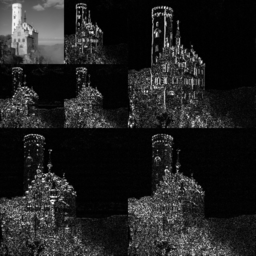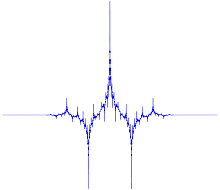- Cohen-Daubechies-Feauveau wavelet
-
For other uses of "CDF", see CDF (disambiguation).
Cohen-Daubechies-Feauveau wavelet are the historically first family of biorthogonal wavelets, which was made popular by Ingrid Daubechies[1][2]. These are not the same as the orthogonal Daubechies wavelets, and also not very similar in shape and properties. However their construction idea is the same.
The JPEG 2000 compression standard uses the biorthogonal CDF 5/3 wavelet (also called the LeGall 5/3 wavelet) for lossless compression and a CDF 9/7 wavelet for lossy compression.
Contents
Properties
- The primal generator is a B-spline if the simple factorization qprim(X) = 1 (see below) is chosen
- The dual generator has the maximum number of smoothness factors which is possible for its length.
- All generators and wavelets in this family are symmetric.
Construction
For every positive integer A there exists a unique polynomial QA(X) of degree A-1 satisfying the identity
 .
.
This is the same polynomial as used in the construction of the Daubechies wavelets. But, instead of a spectral factorization, here we try to factor
 ,
,
where the factors are polynomials with real coefficients and constant coefficient 1. Then,
and
form a biorthogonal pair of scaling sequences. d is some integer used to center the symmetric sequences at zero or to make the corresponding discrete filters causal.
Depending on the roots of QA(X), there may be up to 2A − 1 different factorizations. A simple factorization is qprim(X) = 1 and qdual(X) = QA(X), then the primary scaling function is the B-spline of order A-1. For A=1 one obtains the orthogonal Haar wavelet.
Tables of coefficients
For A=2 one obtains in this way the LeGall 5/3-wavelet:
A QA(X) qprim(X) qdual(X) aprim(Z) adual(Z) 2 1 + X 1 1 + X 

For A=4 one obtains the 9/7-CDF-wavelet. One gets
 , this polynomial has exactly one real root, thus it is the product of a linear factor
, this polynomial has exactly one real root, thus it is the product of a linear factor  and a quadratic factor. The coefficient c, which is the inverse of the root, has an approximate value of -1.4603482098.
and a quadratic factor. The coefficient c, which is the inverse of the root, has an approximate value of -1.4603482098.A QA(X) qprim(X) qdual(X) 4 


For the coefficients of the centered scaling and wavelet sequences one gets numerical values in an implementation–friendly form
k Analysis lowpass filter (1/2 adual)
Analysis highpass filter (bdual)
Synthesis lowpass filter (aprim)
Synthesis highpass filter (1/2 bprim)
-4 0.026748757411 0 0 0.026748757411 -3 -0.016864118443 0.091271763114 -0.091271763114 0.016864118443 -2 -0.078223266529 -0.057543526229 -0.057543526229 -0.078223266529 -1 0.266864118443 -0.591271763114 0.591271763114 -0.266864118443 0 0.602949018236 1.11508705 1.11508705 0.602949018236 1 0.266864118443 -0.591271763114 0.591271763114 -0.266864118443 2 -0.078223266529 -0.057543526229 -0.057543526229 -0.078223266529 3 -0.016864118443 0.091271763114 -0.091271763114 0.016864118443 4 0.026748757411 0 0 0.026748757411 Numbering
There are two concurring numbering schemes for wavelets of the CDF family.
- the number of smoothness factors of the lowpass filters, or equivalently the number of vanishing moments of the highpass filters, e.g. 2,2
- the sizes of the lowpass filters, or equivalently the sizes of the highpass filters, e.g. 5,3
The first numbering was used in Daubechies' book Ten lectures on wavelets. Neither of this numbering is unique. The number of vanishing moments does not tell about the chosen factorization. A filterbank with filter sizes 7 and 9 can have 6 and 2 vanishing moments when using the trivial factorization, or 4 and 4 vanishing moments as it is the case for the JPEG 2000 wavelet. The same wavelet may therefore be referred to as "CDF 9/7" (based on the filter sizes) or "biorthogonal 4.4" (based on the vanishing moments).
Lifting decomposition
For the trivially factorized filterbanks a lifting decomposition can be explicitly given.[3]
Even number of smoothness factors
Let n be the number of smoothness factors in the B-spline lowpass filter, which shall be even.
Then define recursively
The lifting filters are
Conclusively the interim results of the lifting are
- x − 1(z) = z
- x0(z) = 1

which leads to
The filters xn / 2 and xn / 2 − 1 constitute the CDF-n,0 filterbank.
Odd number of smoothness factors
Now, let n be odd.
Then define recursively
The lifting filters are
Conclusively the interim results of the lifting are
- x − 1(z) = z
- x0(z) = 1


which leads to
- x(n + 1) / 2(z)∼(1 + z)n
where we neglect the translation and the constant factor.
The filters x(n + 1) / 2 and x(n − 1) / 2 constitute the CDF-n,1 filterbank.
External links
- JPEG 2000: How does it work?
- Fast discrete CDF 9/7 wavelet transform source code in C language (lifting implementation)
- CDF 9/7 Wavelet Transform for 2D Signals via Lifting: Source code in Python
References
- ^ Cohen, Albert; Daubechies, Ingrid; Feauveau, Jean-Christophe (1992). "Biorthogonal bases of compactly supported wavelets". Comm. Pure & Appl. Math 45: pp. 485-560.
- ^ Daubechies, Ingrid (1992). Ten Lectures on wavelets.
- ^ Thielemann, Henning (2006). "section 3.2.4". Optimally matched wavelets (PhD thesis). http://nbn-resolving.de/urn:nbn:de:gbv:46-diss000103131.
Categories:- Biorthogonal wavelets
Wikimedia Foundation. 2010.










